#Congkit
Text
So I've been playing around with Cāngjié…
And I thought a post like this (similar to a post on Zhùyīn done by linghxr) may be of interest to some.
Edited: 10 Sep 2023
This post has gotten a little popular lately and on scrutinizing my own post again, I've come to the conclusion that I had made some mistakes in my given character examples.
Amended now. Namely, 「唔」 and 「龍」 have now been swapped over in the examples.
「唔」 is really the “3-parts”, and 「龍」 is indeed a “2-parts” character! Amendments are reflected in orange.
What (and who) is Cāngjié?
For those who may not know, Cāngjié is another way to input 漢字/汉字 (Hànzì — Chinese characters). It is way less popular than Pinyin (or even Zhuyin) but it still has its fans, and has a few advantages over the other two.
Cāngjié is also the name of the mythical figure in Chinese legend who is said to have been the inventor of 漢字/汉字, for which Cāngjié (the input system) was named after.
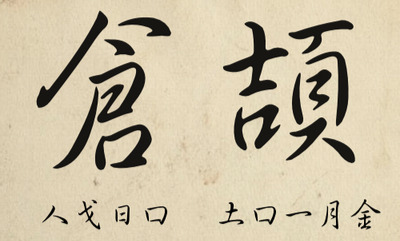
Would I recommend it?
Yes, if you think you have already acquired a good (enough) understanding of 漢字/汉字, and/or just like a new challenge.
(TL;DR at the end)
Why am I learning Cāngjié (and why you may like to, too)?
1. Mostly for fun.
Have long been intrigued by both Cāngjié and Zhùyīn, and since I finally mustered up the courage to tackle Zhùyīn not too long ago, I thought I'd finally give Cāngjié a try.
While learning Cāngjié does require more effort than learning Pinyin or Zhuyin, it can also be really fun! Inputting 漢字/汉字 with the Cāngjié method is almost like doing a jigsaw puzzle.
The euphoria derived from figuring out and piecing together the radicals that make up a word is something that learning Jyutping (Cantonese equivalent of Pinyin), Pinyin or Zhuyin can't quite match.
And while I know I'll never be as adept with Cāngjié — my knowledge of 漢字/汉字 is nowhere near good enough to ever use Cāngjié efficiently — as I do Jyutping or Pinyin (or to some extent, Zhuyin), it'll still be fun to use Cāngjié every once in a while!
2. Helps with thinking and typing in Chinese.
The upshot of relying too much on using Jyutping/Pinyin/Zhuyin is, I'd tend to think in Roman letters or ㄅㄆㄇㄈ before I'd even think about the actual 漢字/汉字.
But with Cāngjié, because it's based on knowing radicals and joining them together to form actual characters, it'll encourage thinking of 漢字/汉字 first, so I think that would help some with 漢字/汉字 memory retention.
Now you may be thinking, why not just you know, practise actually writing then? That is the tried and proven method to better remember 漢字/汉字 after all?
Yes, of course I can do that — and am doing so occasionally — but we live in a digital age now, and the probability and opportunity to type things out is much higher than actually writing stuff by hand.
The idea here is, more looking to think of and envision characters fully in my head, and trying to lessen over-reliance on Jyutping/Pinyin/Zhuyin.
And this is where I find Cāngjié can be useful, which leads to my next point…
3. Haunted by “What if” scenario.
What if there comes a day (however improbable) where I'm presented with only a Cāngjié keyboard to use for typing Chinese? It has happened with Zhùyīn for me!
That means, no Pinyin or Zhuyin keyboards, no Handwriting tools/touchscreens to write with fingers/mouse, no speech-to-text, and no option to copy-and-paste characters from somewhere else either! What then?
4. Able to type without knowing pronunciation, and with more accuracy.
Cāngjié is shape-based. Unlike Jyutping/Pinyin/Zhuyin, where you have to know what a character sounds like before you can type it out, with Cāngjié, you can type out (again assuming no Handwriting or other tools available) characters without needing to know how to pronounce them at all.
With shape-based typing, you'd also get more accurate hits in the first few 漢字/汉字 that show up, versus sound-based methods like Pinyin where for e.g., typing out “wan” will get you a whole list under the same sound and you may have to scroll through a whole lot to get the exact “wan” you need.
You can also type both Traditional and Simplified characters without having to toggle something or switch keyboards.
So how does one begin learning Cāngjié?
Install a Cāngjié keyboard.
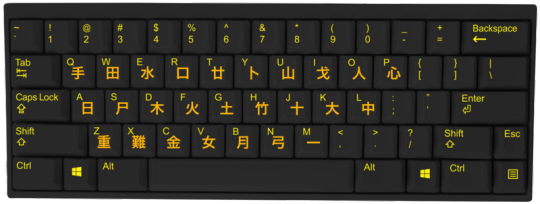
Duh…but of course! Heh! Gboard offers one, banded under Cantonese language input (Android user here, don't know about iPhones, sorry).
There are two versions of Cāngjié that are prevalent currently. Cāngjié 3 and Cāngjié 5. Cāngjié 5 is supposed to be an improvement over version 3 but I don't find there's much; having a slightly altered version just adds to the confusion and unnecessarily complicates matters, in fact!
If you have a choice, I'd recommend selecting Cāngjié 3 as that is more supported. Some operating systems may not be too compatible with Cāngjié 5 still, for some strange reason.


You may also come across something called “Quick” (速成) aka, “Simplified Cāngjié”.
This is simply a scaled down version of Cāngjié, it's still based on Cāngjié's formula. So you still need to know how Cāngjié works in order to use “Quick” efficiently.
You'd then need a chart like this. ↓

* the 重 (Z) key doesn't really come into use. I don't really know what it's for, but it seems to be used (paired with other keystrokes) mainly to type out various punctuation marks.
There are variants out there, some having a little more, or less, radicals shown than in the above example, but I'll say the chart here is one of the more comprehensive ones I've found so far (and sufficient enough) — other charts often fail to highlight the 難 (X) key and what it corresponds to.
You don't have to memorize the chart all at once. Just always have a chart like this on hand to refer to and with enough typing practise, you'll eventually remember which key corresponds with which radicals.
Remember the rules. ↓
“1 part” character (e.g. 寫) = first 3 & last (radical).
“2 parts” character (e.g. 唔龍) = first & last, first 2 & last.
“3 parts” character (e.g. 難) = first & last, first & last, last.
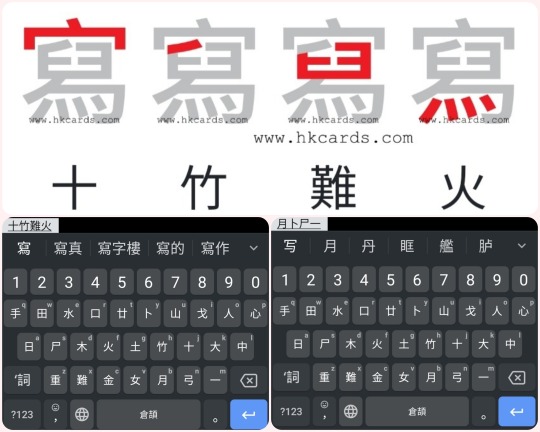
e.g. 寫 ↓
With radicals 宀,丿,臼 (first 3) and 灬 (last).
Corresponding keys: 十,竹,難 and 火。
寫 → 写 ↓
With radicals 冖,���,㇆ (first 3),一 (last).
Corresponding keys:月,卜,尸 and 一。
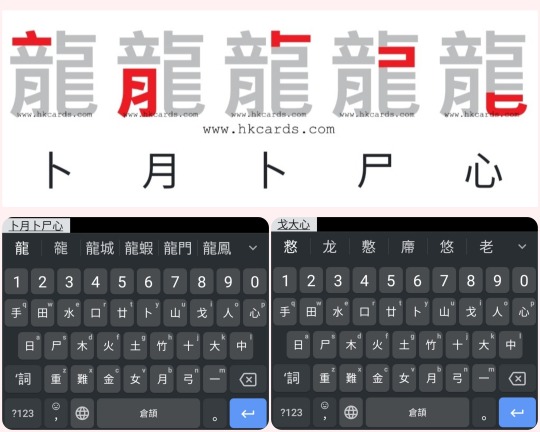
e.g. 龍 ↓
With radicals 亠,月 (first & last), 卜,コ (first 2),ヒ (last).
Corresponding keys: 卜,月,卜,尸,and 心。
龍 → 龙 ↓ (Simplified 龍 → 龙,a “1 part” character)
With radicals 丶,ナ,ヒ (first 3).
Corresponding keys: 戈,大,and 心。

e.g. 難 ↓
With radicals 廿,人 (first & last),亻(first & last),土 (last).
Corresponding keys: 廿,人,人 and 土。
難 → 难 ↓
With radicals ヌ (first & last),亻(first & last),土 (last).
Corresponding keys: 水,人,and 土。
Occasionally, you may get a character that looks like a “2 parts” but is actually a “3 parts”. ↓


e.g. 唔 ↓
With radicals 口 (first & last),一,一 (first & last),口 (last).
Corresponding keys: 口,一,一 and 口。
Or looks like a “1 part” but really a “3 parts”. ↓
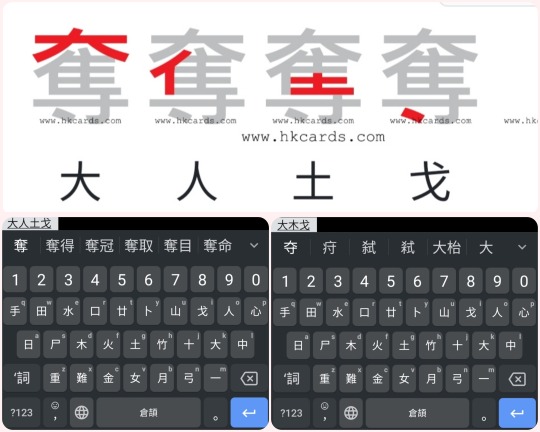
e.g. 奪 ↓
With radicals 大 (first & last),亻,土 (first & last),丶 (last).
Corresponding keys: 大,人,土,and 戈。
奪 → 夺 ↓(Simplified 奪 → 夺,a “1 part” character)
With radicals 大,寸 (first 3; the 丶 is the 3rd component).
Corresponding keys: 大,木,and 戈。
But these are exceptions, and don't occur that often.
And you can start practising!
You can try out this pretty good app called 『五色學倉頡』 (learning Cāngjié with 5 colours), for practise. It's on Playstore, just search for “Cangjie Dictionary” and it should show up.
You have to pay to unlock higher levels, unfortunately. ↓


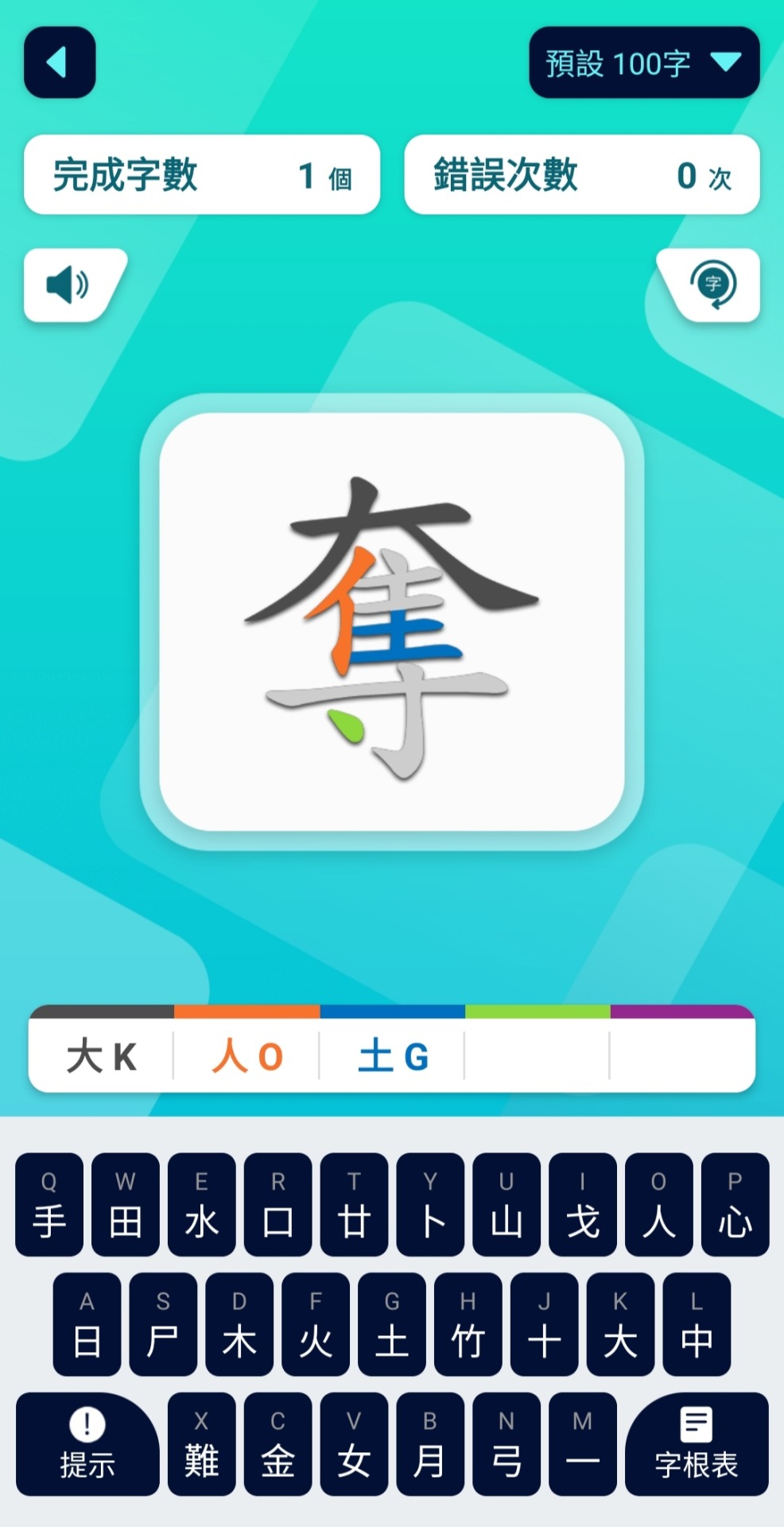
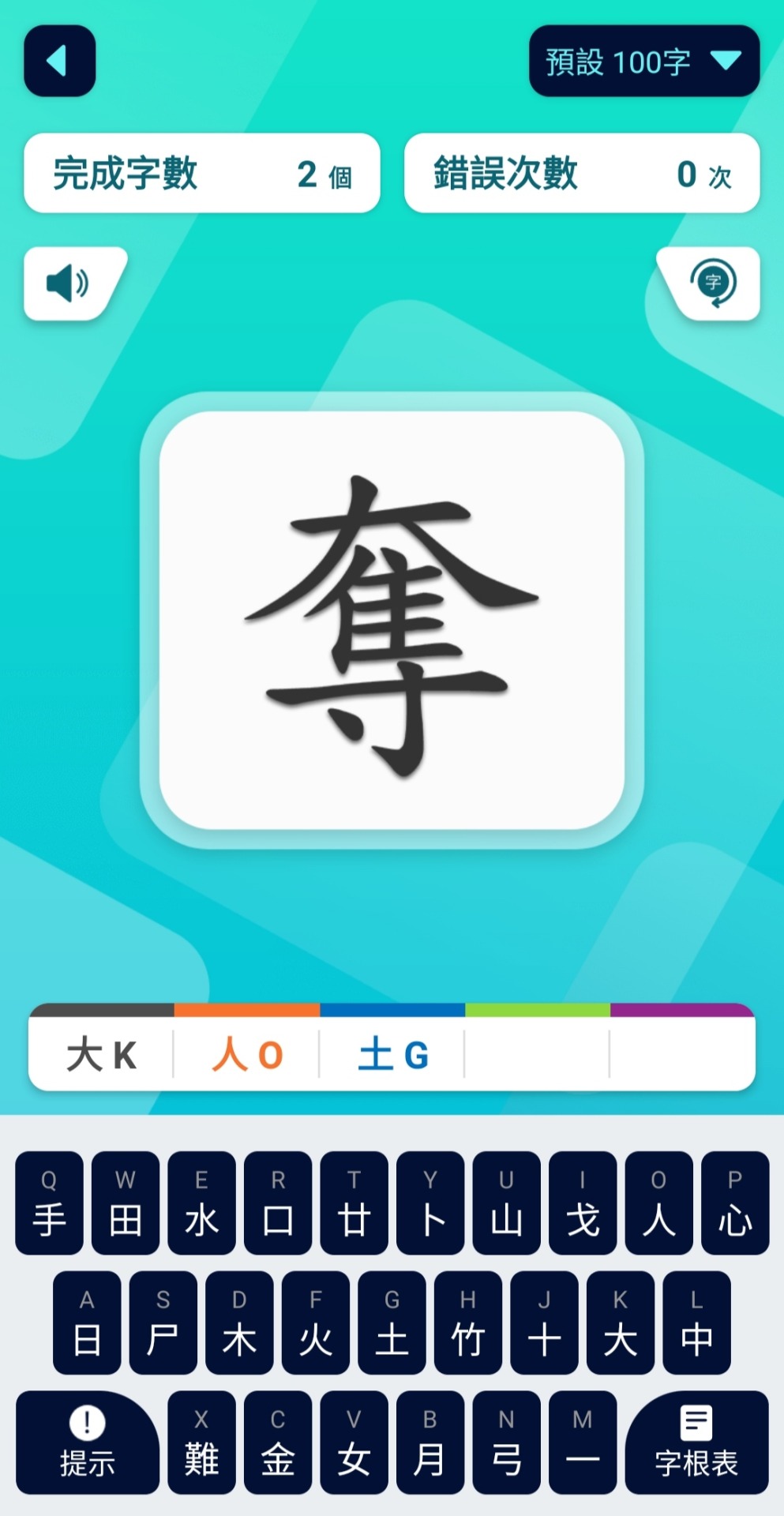

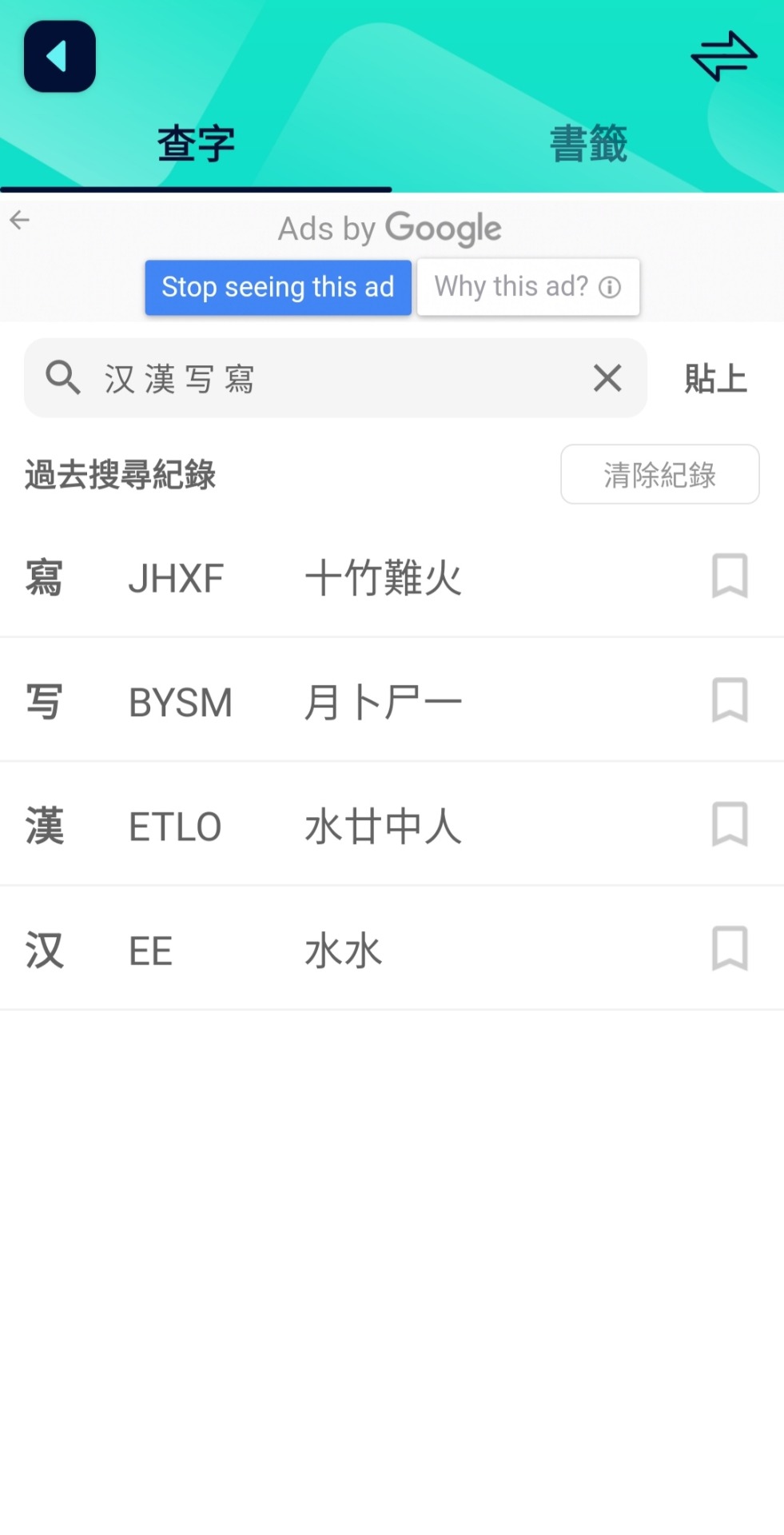
Anyway, each character comes with colour coded hints and you can opt to turn them off if you like more of a challenge. There are also hints (提示) and the chart (字根表) to refer to if you're really stuck. Also has a dictionary component (查字典) to check out the Cāngjié input for characters.
Another option would be a website called HKCards. ↓


You can use it to check the Cāngjié input for any 漢字/汉字, and there's section for practise (倉頡輸入法練習) as well. After inputting your answer with Cāngjié keys (手田水口廿卜), you can click on the “Answer” (答案) button to see how right or wrong your answers were. ↓

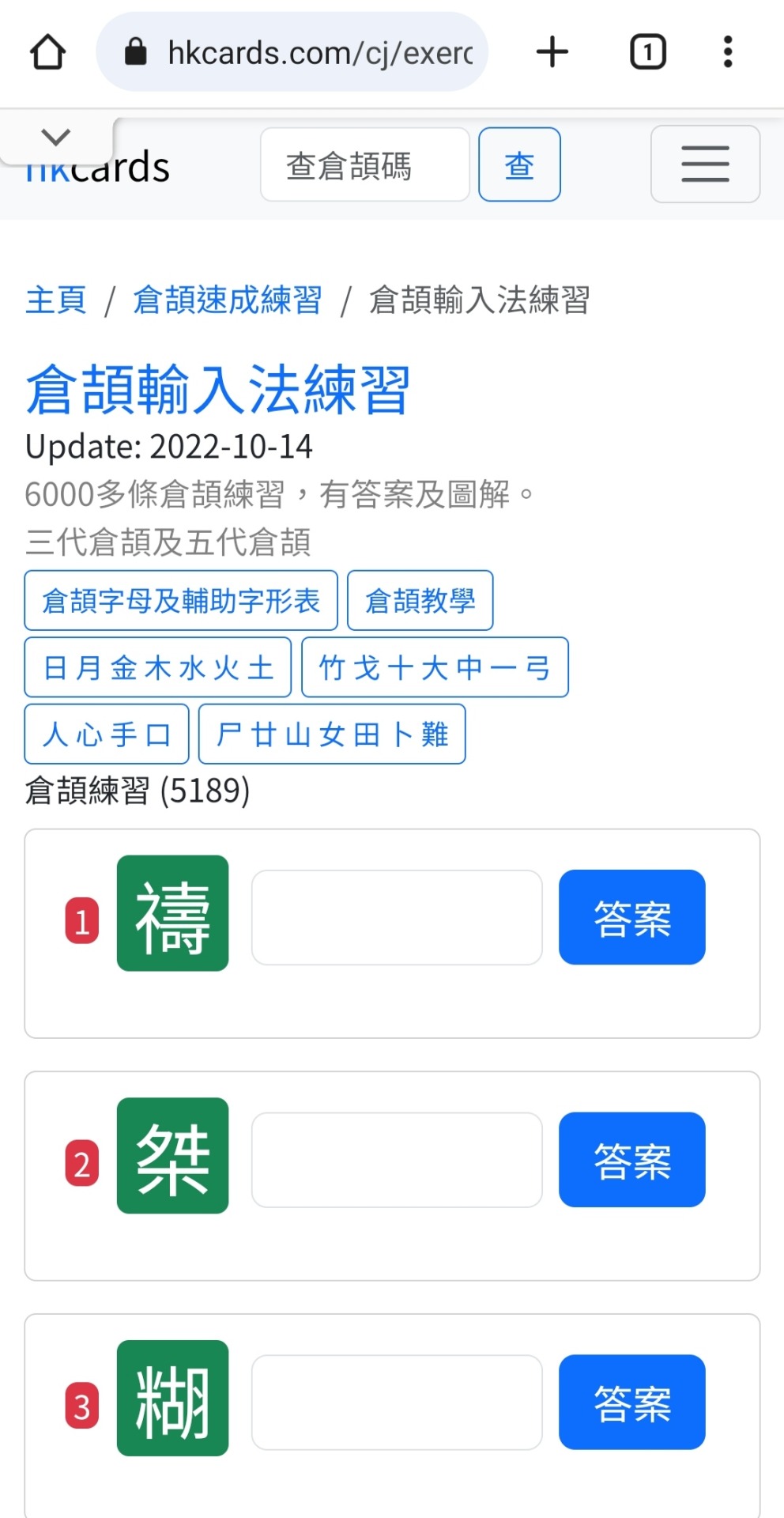
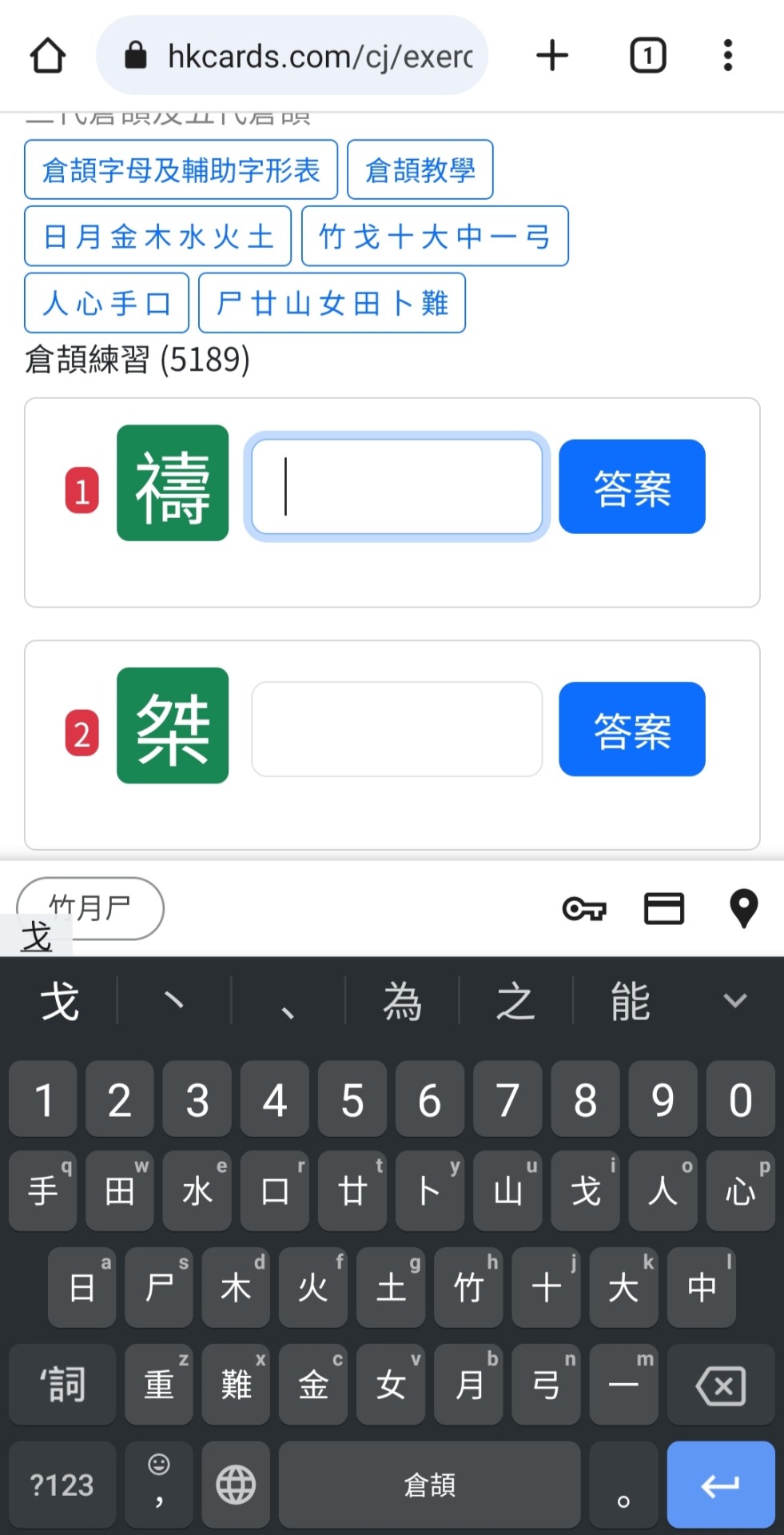

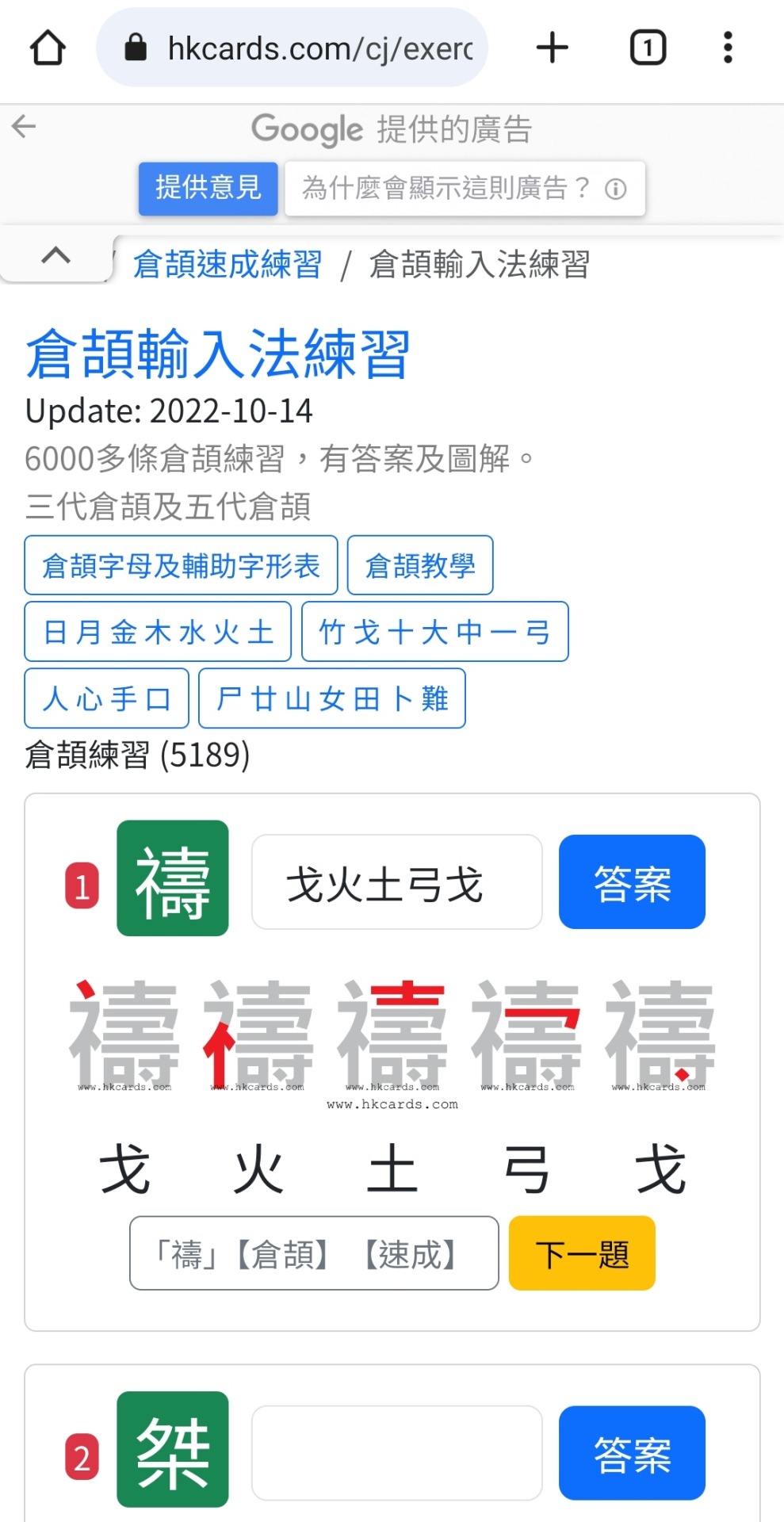
There are 8 characters each time, and you can just hit “Practise Again” (再做練習) to refresh for another 8 to practise with. I've yet to hit a limit.
Unfortunately, this website has lots of ads popping up. And it only supports searching in Traditional characters (Cāngjié was initially catered more for Traditional).
Or you can just try practising randomly with a Cāngjié keyboard and check for mistakes with a Cāngjié dictionary (『五色學倉頡』 app's dictionary comes in really useful here — it appears to support searching in Simplified too).
TL;DR
Cāngjié could be useful (and fun) to know if your 漢字/汉字 knowledge is already adequate, and/or you just like a new challenge.
And if watching videos is more your thing, here's a really helpful YouTube tutorial on how to use Cāngjié (has English subs)!
#Cangjie#Congkit#Cantonese#Mandarin#Jyutping#Pinyin#Zhuyin#Bopomofo#Traditional Characters#Chinese Language#Language#Long Post#Dake Rambles
243 notes
·
View notes
Text



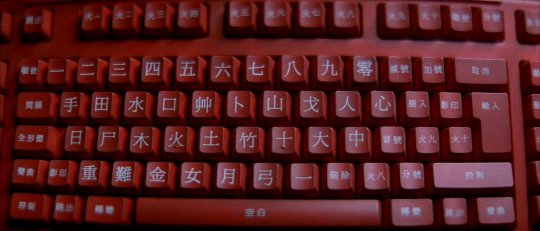
↑ Fake 倉頡 Congkit/Cangjie keyboard in Tomorrow Never Dies (1997).
The funny thing is, the 倉頡 keys (and placement) are accurate enough; it is possible the 艸 character is used in place of the more commonly seen 廿.
But the other keys (like the numeral keys 一、二、三, etc. accurately translated they may be) being either unnecessarily rendered in 漢字 (Chinese characters), or placed wrongly (like the 刪除 “delete” where the 逗號 “comma” key usually goes), or just bizarre (like what are 火八 “fire eight” and 火九 “fire nine” keys?), makes this obviously a joke keyboard! 😹

↑ Another imagining of the TND fake keyboard.
The naming and placement of the keys here at least matches up more accurately to a hypothetical, totally 漢字 keyboard.
(note the 逗號 key next to the 一 (M) key, rather than the 刪除, and no weird 火八、火九、火十 keys placed randomly, like shown in the movie prop!)
Actually…I wouldn't mind having a keyboard like this, just for the kicks! Unnecessary and pretentious it may be! 😹
↓ Examples of real 倉頡 keyboards.

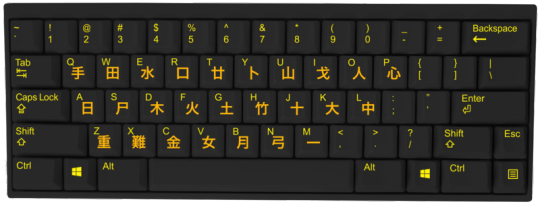

#I was just trying to look up something related to#Cangjie#Congkit#Cantonese#Mandarin#Chinese Language#Language#And this showed up unexpectedly#I've never seen#Tomorrow Never Dies#So it is a pleasant surprise to find this out now!#Michelle Yeoh#Pierce Brosnan#Western Movies#Movies
110 notes
·
View notes
Text
倉頡 Cangjie's rules, explained in pictures.
Great supplement for my earlier post, especially for people who don't do so well with text-heavy posts.
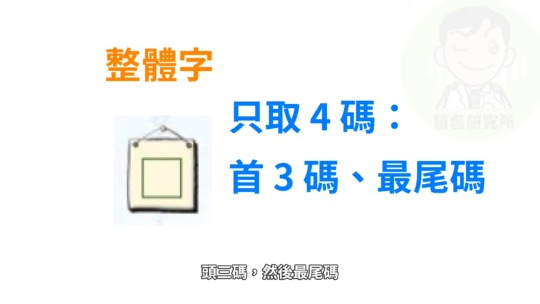
↑ Single component character (first 3 & last radicals)





************************************

↑ Two components character (first & last, first 2 & last)

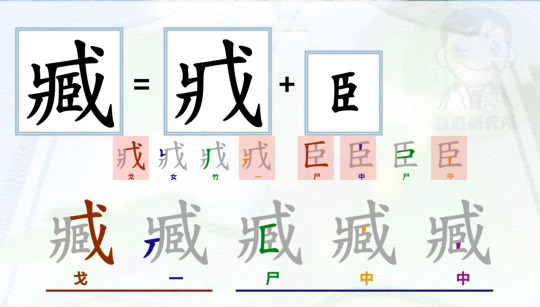

************************************

↑ Three components character (first & last, first & last, last)




************************************
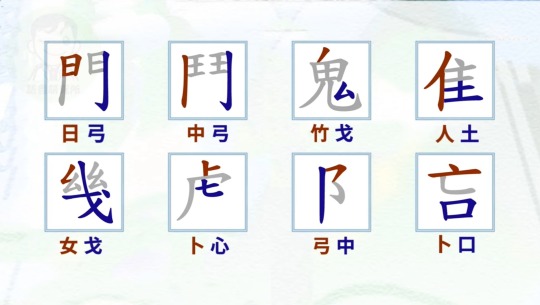
↑ Fixed exceptions (quote from Wikipedia: “Some forms are always decomposed in the same way, whether the rules say they should be decomposed this way or not. The number of such exceptions is small.”)
e.g.: 門's input is always just 日弓,and not say…中日日弓,despite it looking like it should be that.
n.b. on e.g.: In a character like say…贏,the 吂 part is always inputted as 卜口, even though it looks like it should be 卜女口.
2nd n.b. on e.g.: In a character like 鬼,depending on your Cangjie keyboard version, it could be inputted as 竹戈 or 竹山戈,but I think most keyboards are now improved enough to make up for the differences — mine does at least! Whether I type 竹戈 or 竹山戈,the 鬼 character would turn up within the first two options for me.

↑ 難 (X) key components


[Video Ref] (in Cantonese)
5 notes
·
View notes
Text
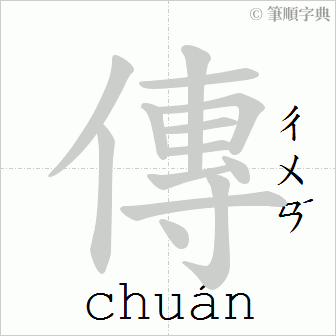

傳 (cyun4/zyun6):人十戈戈
傅 (fu2/fu6):人戈月戈
傳 Zhuyin = ㄔㄨㄢˊ/ㄓㄨㄢˋ,傅 Zhuyin = ㄈㄨˋ
傳 Pinyin = chuán/zhuàn,傅 Pinyin = fù
Used to have difficulty remembering/differentiating between 「傳」 and 「傅」, but with the help of Cangjie/Congkit, I find I remember better now! (here's me, extolling advantages of Cangjie/Congkit! 笑) Also helps to remember:
「傳」: 傳聞,傳統,傳說
「傅」:師傅*
5 notes
·
View notes
Text
自訓話
竹月山•卜口中中中•卜口竹十口
小龍女師父,賜畀我一啲力量吧!
弓金•卜月卜尸心•女•竹口一中月•金大,月金日心竹•田一中•竹手戈•一•口竹日戈•大尸•日一田土•口日山!
Grant me some strength, Master Little Dragon Maiden!
Just thought the dialogues below taken out of context, makes for a very good pep talk with myself (haha) with regards to learning (attempting to anyway) Cangjie, aka Congkit…

「只要你跟住我教你嘅口訣心法去修練」
「口金•一田女•人弓火•口一日女•人卜土•竹手戈•十木人大•人弓火•口日戈山•口•卜口木大•心•水土戈•土戈•人中人竹•女火木田火」
“As long as you follow what I taught you and practise”
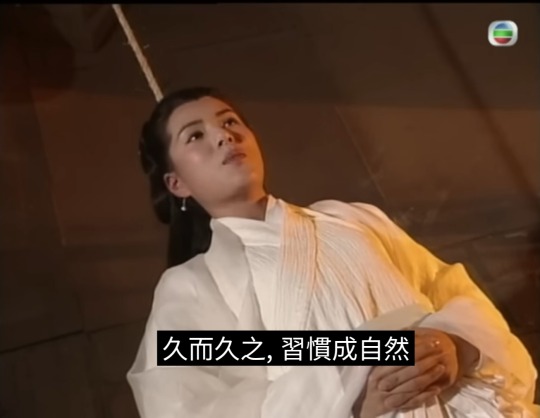
「久而久之,習慣成自然」
「弓人•一月中中•弓人•戈弓人,尸一竹日•心田十金•戈竹尸•竹月山•月大火」
“In time, habit becomes second nature”
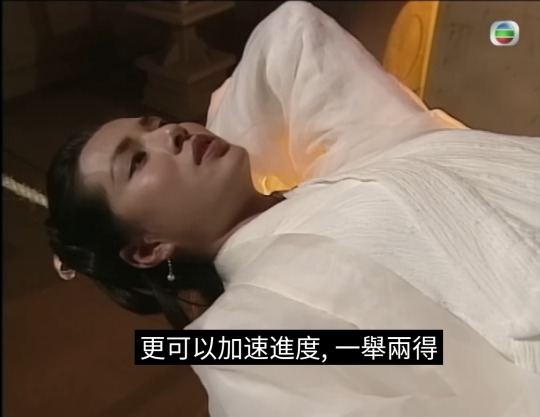
「更加可以速進度,一舉兩得」
「一中田大•大尸口•一弓口•女戈人•卜木中•卜人土•戈廿水,一•竹金手•一中月人•竹人日一戈」
“And you'll progress speedily, killing two birds with one stone”
#Cangjie#Congkit#Goes against everything I've been taught about#Writing Chinese characters at school! A lot to unlearn#Dake Rambles#Cantonese#HK Drama#Condor Heroes 95#TVB#Wuxia#Carman Lee#Return of the Condor Heroes#Chinese Language#Language#My Caps
3 notes
·
View notes
Text

呢個覽表睇起容易参考多啲。(喺『五色學倉頡』截屏嘅)
2 notes
·
View notes
Text
一啲進展
一•口竹日戈•卜人土•尸廿女
倉頡嘅學習仍然摱緊。
人戈日口•土口一月金•口日戈山•竹月弓木•尸一竹日•人弓竹尸•月大火•手日田水•尸水女戈火。
雖然速度非常,非常慢。
口戈人土•月大火•卜木中•戈廿水•中一卜卜卜•火月口中月,中一卜卜卜•火月口中月•心日田水。
倉頡筆劃嘅規則又有時複雜,又死板,難明。
人戈日口•土口一月金•竹中手•中一中弓•口日戈山•手人月山山•月金中弓•弓大•大月•日土木戈•中人日水•卜木人土,弓大•一弓心•木竹水,廿人人土•日月。
但係,試用緊倉頡鍵盤嘅時候,
人日一•人竹女火,卜口戈心一•月手•尸水女戈火•人戈日口•土口一月金•金弓大手•竹水月廿•口日戈山•日土木戈•人中弓大,
先發覺曾經所明白嘅字體造型筆劃法,
竹土竹山•弓人弓竹水•竹月月山•金田日•女火一女一•竹尸竹一中•日月•竹日•口日戈山•十弓木•月月廿田廿•卜竹土口•一弓土•竹中手•中一中弓•水土戈,
就算冇倉頡規則加埋嘅混亂,
卜火戈大山•竹月山廿•大月•人戈日口•土口一月金•手人月山山•月金中弓•十尸口•土田土•口日戈山•水日心心•月月山,
仲好膚淺,仲好未到家!
人中•女弓木•卜心田月•水戈戈,人中•女弓木•十木•一土中弓•十一尸人!
學用倉頡輸入法果然對中文了解大有幫助!
竹月弓木•月手•人戈日口•土口一月金•十十人一弓•人竹•水土戈•田木•月大火•廿土木戈•中•卜大•弓弓•弓月尸竹手•大•大月•土戈竹日月•月一大尸!
起碼可以說服自己學倉頡冇完全白費心機!(笑)
土人口山•一口尸手火•一弓口•女戈人•卜口金口山•月尸中水•竹月山•尸山•竹月弓木•人戈日口•土口一月金•大月•十一一山•人一土•竹日•中弓月山金•心•木女戈戈!(竹竹大)
而而家,經過一排嘅苦練之後,
一月中中•一月中中•十一尸人,女火一女一•卜月月口•一•手中一卜•口日戈山•廿十口•女火木田火•戈弓人•竹人女戈水,
終於有一啲成績可睇得出嘞!
女火竹水卜•卜尸人卜•大月•一•口竹日戈•戈竹尸•女火手一金•一弓口•月山金弓竹•竹人日一戈•山山•口廿十尸!
以上同下嘅句子,係逐字逐句,
女戈人•卜一•月一口•一卜•口日戈山•心口•弓木,人竹女火•卜一尸人•十弓木•卜一尸人•心口,
慢慢用倉頡鍵盤打出嚟㗎!
心日田水•心日田水•月手•人戈日口•土口一月金•金弓大手•竹水月廿•手一弓•山山•口竹竹水•口大口木!
而且冇偷懶,就算有快捷鍵方式出現,
一月中中•月一•大月•人人一弓•心木中金,卜火戈大山•竹月山廿•大月•心木大•手十中人•金弓大手•卜竹尸•戈心一•山山•一土月山山,
都特登揀全面方式嚟打出每隻字喎!
十日弓中•竹手土木戈•弓人一口廿•手木田火•人一土•一田卜中•卜竹尸•戈心一•口竹竹水•手一弓•山山•人田卜戈•人土水•十弓木•口月月口!

我而家滿足感似以上嘅史迪仔一樣!(笑)
竹手戈•一月中中•十一尸人•水廿中月•口卜人•戈口心•人女戈人•女戈人•卜一•口日戈山•中大•卜中田•人弓木•一•木廿土水!(竹竹大)
希望(似小龍女師父講過 笑)久而久之,
大大中月•卜月竹土(人女戈人•弓金•卜月卜尸心•女•竹口一中月•金大•卜口廿廿月•卜月月口 •竹竹大)弓人•一月中中•弓人•戈弓人,
習慣真係會成自然啦!
尸一竹日•心田十金•十月一金•人竹女火•人一田日•戈竹尸•竹月山•月大火•口手卜廿!
#請容許我自豪一下,我使咗好多時間同心機嚟了解同練習點用倉頡輸入法嘅!#Once you start getting the hang of the#Cangjie#Congkit#Puzzle…and voilà! Indescribable satisfaction!#Dake Rambles#Cantonese#Canto Practise#Chinese Language#Language#Lilo and Stitch#Stitch Has a Glitch#Disney#Stitch
1 note
·
View note
Text

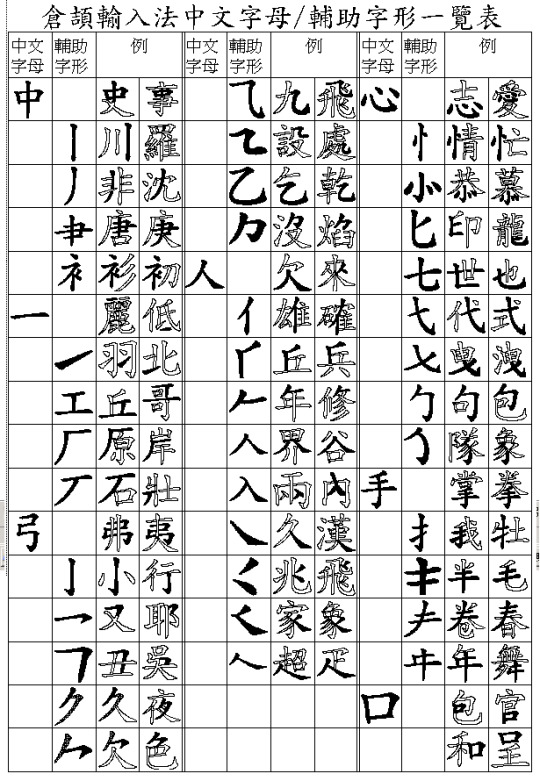
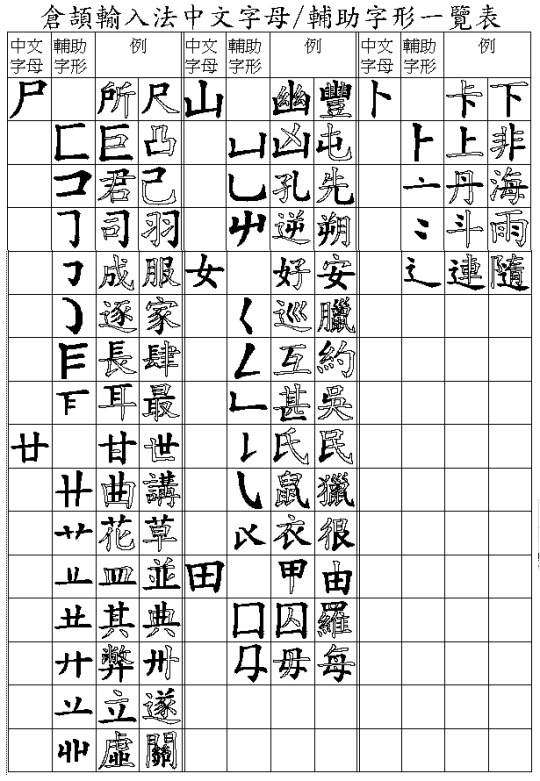
多一個詳細嘅倉頡輸入法覽表。
1 note
·
View note
Text
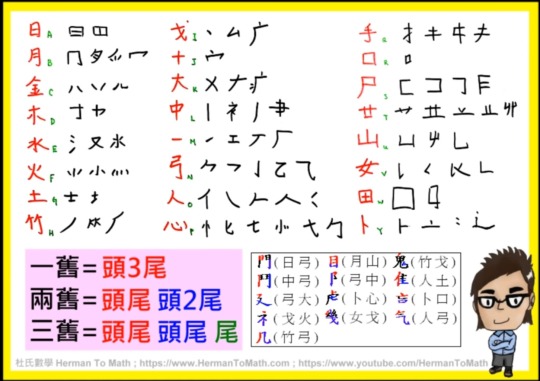
倉頡指點輸入法插圖表

將幾張圖擺喺呢度先!話唔定,有一日會用得到!
#Was just delving a little more into#Cangjie#Congkit#Always have been intrigued by it#Doubt I'll actually learn this method#Not with my poor understanding of Chinese characters#But just in case#Good to have this around#Cantonese#Chinese Language#Language
1 note
·
View note
Text

2 notes
·
View notes
Text

If only this ↑ could've been actually established!
Someone on Reddit came up with, and proposed a version of a simplified Cantonese Bopomofo chart a while ago that I thought was really neat!
Certainly looks cleaner than the Cantonese Bopomofo systems that came out in the 1930s and '50s, which ultimately failed to take off also.
But going by the comments with this proposed Cantonese Bopomofo post, hardly anyone seemed in favour of it and if that is the general sentiment regarding Cantonese Bopomofo, guess it will not be making a comeback any time soon. Pity!
Not dismissing the hard work and good intentions that went into creating Jyutping (Cantonese Romanization method) of course! And I like Jyutping well enough, and will be forever grateful for its existence; it made Cantonese learning that much easier for an English-centric learner like myself.
But it certainly would have been great (and fun) to have another non-Romanization option to learn (and type out) Cantonese with sometimes, when the other commonly available options — namely 倉頡 (Cangjie/Congkit) and 筆劃 (Strokes) — prove too complex for my (current) abilities.
Sadly, there are currently no Cantonese Bopomofo keyboard input systems available for wider access, as far as I know.
12 notes
·
View notes